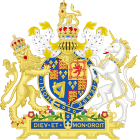Root and Branch petition
 | |
| Introduced by | Henry Vane and Oliver Cromwell (Commons) |
|---|---|
| Territorial extent | England |
| Dates | |
| Made | February 1641 |
| Laid before Parliament | May 1641 |
| Other legislation | |
| Relates to | Clergy Act 1640 |
Status: Not passed | |
| Text of statute as originally enacted | |
The Root and Branch Petition was a petition presented to the
Debate

When the petition was debated in the
This petition formed the basis of the Root and Branch Bill, which was drawn up by Oliver St John and introduced in Parliament by Henry Vane[6] and Oliver Cromwell in May 1641.[7]
The first reading of the bill was moved by Edward Dering, not because he agreed with it, but because he thought the radical idea of abolishing the episcopacy would force the passage of the more moderate Clergy Act.[8] He went on to oppose the bill while it was in committee, defending the idea of a "primitive episcopacy", which would bring bishops into line with the rest of the clergy.[9] In one speech in the House of Commons, Dering was quoted as saying:
"Parity of degrees in Church Government hath no foundation in holy scripture, and is as treasonous to reason as parity in a state or family. Indeed it is a fancy, a dream, a mere non-entity; it neither hath nor never had a being. If it be any thing, it is absolute Anarchism, and that is nothing; for privation of government is not a government."[10]
The bitter debates that the Commons held on the Bill eventually resulted in the indication of parliamentary support for church reform. As a result, mobs started to invade churches, removing "scandalous images" and any other "signs of popery".[11] After lengthy debates, the bill was eventually defeated in August 1641, dying without a vote as more critical matters began to occupy Parliament.[6][12]
Aftermath

In early 1641, the Commons attempted to pass a series of constitutional measures, but the bishops ensured they were rejected by the House of Lords.[13] The Commons responded by introducing the Bishops Exclusion Bill, which would remove them from the House of Lords, but this was also rejected. In December 1641, riots erupted throughout Westminster, which resulted in a number of deaths and prevented the bishops from attending the House of Lords.[14] In January 1642, Charles I fled London, accompanied by many Royalist MPs and Lords; this gave the anti-episcopal faction a majority in both houses, and the bill became law in February 1642.[15]
These heightened tensions led to the outbreak of the First English Civil War in August 1642, in which many of the anti-episcopal faction joined the Parliamentarian side, while their opponents joined the Royalists. On 12 June 1643, the Parliamentarians convened the Westminster Assembly in order to formally restructure the Church of England.[16] Following the end of the First Civil War, the aims of the Root and Branch Bill were ultimately achieved in October 1646, when Parliament passed the Ordinance for the abolishing of Archbishops and Bishops in England and Wales and for settling their lands and possessions upon Trustees for the use of the Commonwealth.[citation needed]
References
- ISBN 978-1784783907.
- OCLC 226127.
- OCLC 503439406.
- ^ Chisholm, Hugh, ed. (1911). . Encyclopædia Britannica. Vol. 10 (11th ed.). Cambridge University Press. p. 328.
- OCLC 1084986.
- ^ OCLC 1084986.
- ISBN 0-582-01675-4.
- ISBN 0140551379.
- ^ Stephen, Leslie, ed. (1888). . Dictionary of National Biography. Vol. 14. London: Smith, Elder & Co.
- OCLC 1050718495.
- OCLC 503439406.
- OCLC 226127.
- ISBN 978-1784783907.
- JSTOR 3817210.
- ISBN 978-0810851009.
- ISBN 978-0-567-66090-9.
